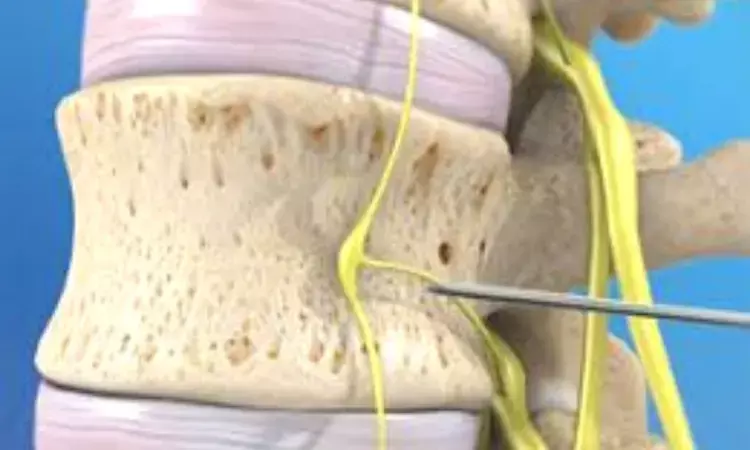- Home
- Medical news & Guidelines
- Anesthesiology
- Cardiology and CTVS
- Critical Care
- Dentistry
- Dermatology
- Diabetes and Endocrinology
- ENT
- Gastroenterology
- Medicine
- Nephrology
- Neurology
- Obstretics-Gynaecology
- Oncology
- Ophthalmology
- Orthopaedics
- Pediatrics-Neonatology
- Psychiatry
- Pulmonology
- Radiology
- Surgery
- Urology
- Laboratory Medicine
- Diet
- Nursing
- Paramedical
- Physiotherapy
- Health news
- Fact Check
- Bone Health Fact Check
- Brain Health Fact Check
- Cancer Related Fact Check
- Child Care Fact Check
- Dental and oral health fact check
- Diabetes and metabolic health fact check
- Diet and Nutrition Fact Check
- Eye and ENT Care Fact Check
- Fitness fact check
- Gut health fact check
- Heart health fact check
- Kidney health fact check
- Medical education fact check
- Men's health fact check
- Respiratory fact check
- Skin and hair care fact check
- Vaccine and Immunization fact check
- Women's health fact check
- AYUSH
- State News
- Andaman and Nicobar Islands
- Andhra Pradesh
- Arunachal Pradesh
- Assam
- Bihar
- Chandigarh
- Chattisgarh
- Dadra and Nagar Haveli
- Daman and Diu
- Delhi
- Goa
- Gujarat
- Haryana
- Himachal Pradesh
- Jammu & Kashmir
- Jharkhand
- Karnataka
- Kerala
- Ladakh
- Lakshadweep
- Madhya Pradesh
- Maharashtra
- Manipur
- Meghalaya
- Mizoram
- Nagaland
- Odisha
- Puducherry
- Punjab
- Rajasthan
- Sikkim
- Tamil Nadu
- Telangana
- Tripura
- Uttar Pradesh
- Uttrakhand
- West Bengal
- Medical Education
- Industry
Sympathetic Blockade with Botulinum Toxin Tied to Pain Relief in Complex Regional Pain Syndrome: Study

South Korea: Lumbar sympathetic ganglion block using botulinum toxin type A raised the temperature of the affected foot for 3 months in patients with complex regional pain syndrome and also reduced the pain, reveals a recent study. The study was published in the February 2022 issue of the journal Anesthesiology.
The study was designed to test the hypothesis that botulinum toxin prolongs the duration of a lumbar sympathetic block measured through a sustained increase in skin temperature. Jee Youn Moon, Seoul National University Hospital, Seoul, Republic of Korea, and colleagues performed a randomized, double-blind, controlled trial to examine the clinical outcome of botulinum toxin type A for lumbar sympathetic ganglion block in patients with complex regional pain syndrome.
For this purpose, the researchers conducted lumbar sympathetic ganglion block in patients with lower-extremity complex regional pain syndrome using 75 IU of botulinum toxin type A (botulinum toxin group) and local anesthetic (control group).
The change in the relative temperature difference on the blocked sole compared with the contralateral sole at 1 postoperative month was the primary outcome. The 3-month changes in relative temperature differences, and the pain intensity changes were the secondary outcomes.
A total of 48 participants (N = 24/group) were randomly assigned.
Based on the study, the researchers found the following:
- The change in relative temperature increase was higher in the botulinum toxin group than in the control group (1.0°C ± 1.3 vs. 0.1°C ± 0.8, respectively), which was maintained at 3 months (1.1°C ± 0.8 vs. –0.2°C ± 1.2, respectively).
- Moreover, pain intensity was greatly reduced in the botulinum toxin group compared with the control group at 1 month (–2.2 ± 1.0 vs. –1.0 ± 1.6, respectively) and 3 months (–2.0 ± 1.0 vs. –0.6 ± 1.6, respectively).
- There were no severe adverse events pertinent to botulinum toxin injection.
"We found that compared with local anesthetic, injections of botulinum toxin type A onto the lumbar sympathetic ganglia increased temperature on the affected foot for 3 months," the authors wrote. This was accompanied by pain reduction and cold tolerance improvement. Moreover, it also improved aching and numbness."
Reference:
Yongjae Yoo, Chang-Soon Lee, Jungsoo Kim, Dongwon Jo, Jee Youn Moon; Botulinum Toxin Type A for Lumbar Sympathetic Ganglion Block in Complex Regional Pain Syndrome: A Randomized Trial. Anesthesiology 2022; 136:314–325 doi: https://doi.org/10.1097/ALN.0000000000004084
Dr Kamal Kant Kohli-MBBS, DTCD- a chest specialist with more than 30 years of practice and a flair for writing clinical articles, Dr Kamal Kant Kohli joined Medical Dialogues as a Chief Editor of Medical News. Besides writing articles, as an editor, he proofreads and verifies all the medical content published on Medical Dialogues including those coming from journals, studies,medical conferences,guidelines etc. Email: drkohli@medicaldialogues.in. Contact no. 011-43720751


